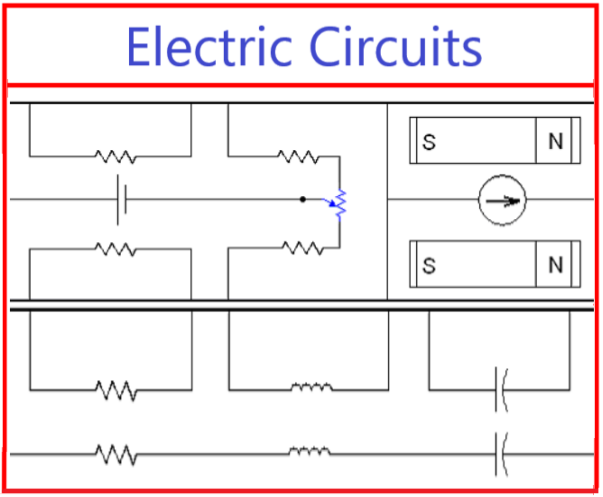
New Generation Publishing
Easy, Hands On Electronics Books
Alireza H. Fassih
Electric Circuits
New Generation Publishing
Copyright © 2023 – Alireza H. Fassih
All rights reserved. No part of this book may be reproduced or transmitted in any form or by any means, electronic or mechanical, including photocopying, xerography, recording, or by incorporating into any information storage or retrieval system, without the written permission from the author. Making copies of any part of this book for any purpose is a violation of United States copyright laws. Unauthorized dissemination, publication or the sale of the any part of this textbook, including posting on the internet is strictly prohibited.
The author or the publisher does not warrant the accuracy of the materials in this book. Neither the author nor the publisher is liable or responsible for any damages or injuries
as a result of using the materials in this book directly or indirectly.
Email: ElectronixBooks@Gmail.com
Websites: www.NewGenerationBooks.com
www.ElectronixBooks.com
Printed in the United States of America
ISBN 978-0-9905015-1-0
Preface
The main purpose of this textbook is a HANDS-ON APPROACH in learning AC / DC electric circuits.
In each section, a component is introduced and then a software/hardware circuit will follow. The software circuit can be implemented by electronic circuit design and simulation software such as Multisim ®.
The main goal of this textbook is to create a vast visualization of the working function of the AC / DC electric circuits. Based on my experience in teaching electronics, students had more problems with setting up the hardware circuits than software circuits. Therefore, one of my main intentions in writing this textbook is to guide the students through setting up a complete wiring of the circuits.
This textbook is a COMPREHENSIVE COVERAGE of the practical working of the DC / AC circuits. This textbook can be used as a textbook and a lab manual in AC / DC electric circuits courses.
Contents
Chapter 1: Basics
1.1 Powers of Ten ……………………………………………………….…………. 2
1.2 Scientific Notation …………………………………………………………….4
1.3 Engineering Notation ………………………………………………………...5
1.4 Structure of an Atom ………………………………………………………6
Exercises ……………………………………………………..……..7
Chapter 2: DC Signal
2.1 DC Signal ………………………………………………………………………..….. 9
2.2 DC Voltage and Current Source………………………………..……….. 10
2.3 Power Supply ………………………………………………………..…………… 12
2.4 Analog and Digital Multi-Meters ………………………………………..14
2.5 Volt-Meter ………………………………………………………………………... 18
2.6 Circuit Board ……………………………………………………….……………...20
Chapter 3: DC Resistive Circuit
3.1 Resistor ……………………………………………….…………………….25
3.2 Ohmmeter …………………………………………………………………28
3.3 Variable Resistor ………………………………………………………. 34
3.4 Color Code of Resistor ……………………………………………….35
3.5 Ohm’s Law …………………………………………………………..……..36
3.6 Electric Power …………………………………………………………….40
3.7 Conventional Current Flow and the Ground ………………41
3.8 Ammeter …………………………………………………………………….42
3.9 Circuit Ground versus Earth Ground ……………..……………46
3.10 Electrical Fuse and Breaker ………………………………………..47
3.11 Voltage-Current Transformation………………….……48
Exercises …………………………………………………….....49
Chapter 4: Series Circuit
4.1 Series Circuit …………………………………………………………….58
4.2 Kirchhoff’s Voltage Law ……………………………………………59
4.3 Total Power in a Series Circuit …………………………………60
Exercises ………………………………………………………………………….66
Chapter 5: Parallel Circuit
5.1 Parallel Circuit ……………………………………………………..72
5.2 Kirchhoff’s Current Law ………………..…………………….73
5.3 Total Power in a Parallel Circuit ………………………....74
Exercises ………………………………………………...84
Chapter 6: Series-Parallel Circuit
6.1 Series and Parallel Batteries …………………….………..90
6.2 Series-Parallel Circuit ………………………………………..91
6.3 Complex Circuit ………………………………………………..92
6.4 Voltage Divider ………….……………………………………..93
6.5 Loading Effect of a Voltmeter …………………………..96
Exercises ……………………………………………….97
Chapter 7: Circuit Theorems
7.1 T or Y Connection …………………………………………….103
7.2 Pi (π) or Delta (∆) Connection …………………………104
7.3 Pi to T Conversion Formulas …………………………….105
7.4 T to Pi Conversion Formulas ……………………………106
7.5 Wheatstone Bridge Circuit ………………………………107
7.6 Thevenin’s Theorem ……………………………….……….108
7.7 Norton’s Theorem ……………………………………...……111
7.8 Superposition Theorem …………………………………..114
7.9 Maximum Power Transfer Theorem……………….…114
Exercises ……………………………………………....116
Chapter 8: Magnetism and Electromagnetic Induction
8.1 Magnetic Field …………………………………………………. 121
8.2 Electromagnetic Field ………………………………………. 122
8.3 Magnetic Flux Density (B) ………………………………… 124
8.4 Hall Effect and Hall Effect Sensor ………………………124
8.5 Permeability and Reluctance of the Material …….124
8.6 Magnetic Circuit ………………………………………………..125
8.7 Magnetic Field Intensity (H) ……………………………….126
8.8 Induced Voltage and Current (Faraday’s Law)…….126
8.9 Lenz’s Law ………………………………….………………….…...127
8.10 Solenoid ……………... ……………………………………………..128
8.11 Relay …………………………………………………………………...129